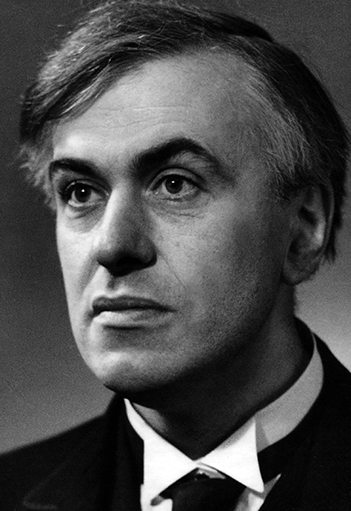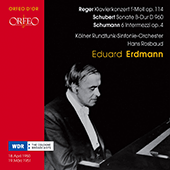Eduard Erdmann
Eduard Erdmann was the youngest of four brothers and began his piano lessons at around the age of eight. A year later Erdmann’s father, who was a lawyer, moved the family to Riga and in 1912 Erdmann began to study with Bror Möllesten, a pupil of Leschetizky. He then had lessons from Jean du Chastain and also received tuition in theory and harmony from the organist of Riga cathedral, Harald Creutzberg. The following year Erdmann’s father died, and his mother moved to Berlin where Eduard studied composition with Heinz Tiessen and piano with Liszt pupil Conrad Ansorge at summer master-classes in Koenigsberg, later becoming a full-time pupil. Erdmann made his debut in Berlin at one of Hermann Scherchen’s ‘Evenings of Contemporary Music’. He played Sechs kleine Klavierstücke Op. 19 by Schoenberg, the Piano Sonata Op. 1 by Alban Berg and his own Klavierstücke Op. 6. In Berlin Erdmann met and was invited to the homes of many prominent musicians including Arthur Nikisch, Ferruccio Busoni, Richard Strauss and Artur Schnabel whose compositions Erdmann championed, giving the first performance of Schnabel’s Piano Sonata. Almost from the first, Erdmann was taken seriously as pianist and composer and from 1921 to 1923 he took part in the Donaueschingen Festival of contemporary chamber music as a member of the jury.
In the early 1920s Erdmann made tours of Scandinavia and Spain and in 1925 was invited by conductor Hermann Abendroth to teach a piano master-class at the Cologne Conservatory. In December 1926 Erdmann played for the opening of the Bauhaus in Dessau and three years later began giving concerts with Walter Gieseking on two pianos, something they did for the next twenty years. In 1929 Otto Klemperer conducted the first performance of Erdmann’s Piano Concerto with its composer as soloist, and in April 1934 Erdmann appeared at London’s Wigmore Hall with violinist Alma Moodie. Moodie, an Australian musician and pupil of Carl Flesch who lived in Berlin, had played Busoni’s Violin Concerto at a Philharmonic Concert in London and now played his Violin Sonata in E minor with Erdmann. The two appeared regularly together from 1920 until Moodie’s death in 1943. In the same programme Erdmann played Bach’s ‘Goldberg’ Variations BWV 988, which was found to be ‘…a little disappointing when compared with his sensitive performance of Busoni and the ‘Kreutzer’ Sonata.’ From the outset, the critic of The Times did grant that Erdmann was ‘a pianist of the finest musical intelligence’. Erdmann was a champion of Busoni’s music and played both the mighty Piano Concerto Op. 39 and the Fantasia contrappuntistica in public.
Erdmann had been performing more abroad from 1936, but as a composer had to play down his image because his compositions were classed as ‘degenerate’ by the Nazis; hence his public activity as a composer was not visible from 1933 to 1945. He also resigned from the Cologne Conservatory when he witnessed Jewish colleagues being attacked by the Nazis. By the time World War II was over, Erdmann’s compositions already seemed dated, so he had to earn his living as a pianist. He retreated to his home at Langballigau, a house that he had purchased in 1923 near the Flensburg Bay not far from the Danish border, and lived there for the rest of his life.
After the war, when Erdmann gave his first concert in Germany, he played four evenings of works by Krenek, Hindemith, Berg and Schoenberg, composers who had been banned by the Nazis. Although he was offered faculty posts in Munich and Berlin, Erdmann declined; however, when asked by his friend Philip Jarnach to give master-classes at Hamburg Conservatory, he agreed. During the late 1940s and early 1950s Erdmann again played more public concerts, but in 1954 suffered his first heart attack. In June 1958 he gave his last concert (in honour of Clara Haskil), and died later that month from another heart attack.
Erdmann has been called ‘the pianist-philosopher’. He was a cultured man who read voraciously; his library was renowned and he had professional and personal relationships with many artists, scientists, writers and, among musicians, Artur Schnabel, Paul Hindemith and Ernst Krenek. Apparently, Erdmann even memorised Dante’s La divina commedia in Italian. He approached piano playing as a science and was analytical to the point of being pedantic in his interpretations. In fact, he did not believe in the artist’s personality being manifest; not a trace of his personality must enter into his performance. He attempted to strip away everything except the music of the composer. Never a Romantic player, Erdmann reveals everything from a studied point of view, delivered in a fashion as objectively as possible. As eclectic as he was in his reading, so he was in his choice of composers. He liked to juxtapose composers such as Bach and Mussorgsky, Schubert and Krenek, or Beethoven and Busoni. His repertoire was wide, and in Berlin between 1919 and 1925 he played, along with works by many then more famous composers, music by Froberger, Kuhnau, Alkan, Smetana, Rachmaninov, Nielsen, Scriabin, Bartók, Schnabel and Jarnach. With Schnabel, Erdmann was one of the few pianists to play the piano sonatas by Schubert from the 1920s onwards. Towards the end of his life he played these sonatas regularly and became associated particularly with Schubert’s last few great works in this form.
In 1928 Erdmann recorded for Polydor in Berlin. All the titles he recorded are of twentieth-century music and include works by Krenek, Smetana, Debussy, Tiessen and Erdmann himself. On 6 September 1935 he performed Beethoven’s Piano Concerto No. 3 in C minor Op. 37 with the BBC Symphony Orchestra and Henry Wood at London’s Queen’s Hall. The following day he recorded some short works by Beethoven and Brahms for Parlophone in London, and when he returned to Berlin recorded the same Beethoven concerto with the Berlin Philharmonic Orchestra and Artur Rother on 17 November 1935. It is a fine performance displaying Erdmann’s solid and unsentimental playing. More recordings were made for Polydor in Berlin in November 1940 including Haydn’s Variations in F minor and Schubert’s twelve German Dances D. 790: many of these 78s have been reissued on two compact discs by the German company Bayer. A large number of Erdmann’s radio broadcasts have survived in German radio archives, and performances from the 1950s of the last great sonatas by Schubert have been issued. Also in the late 1950s EMI Electrola issued some of this material on LP including Schumann’s Fantasiestücke Op. 12 and Schubert’s Impromptus D. 899. Since 1996 the French label Tahra has issued three two-disc sets of Erdmann. The first includes the Beethoven concerto from 1935 already mentioned, as well as broadcasts of a Handel suite, an excellently compelling version of Mussorgsky’s Pictures at an Exhibition, Debussy’s Fantaisie for piano and orchestra and Schumann’s Konzertstück Op. 92. Volume two contains the last four of Schubert’s piano sonatas, whist the third volume contains different recordings of the same Beethoven concerto, some Mozart, and the last two Schubert sonatas as well as Liszt’s Valse oubliée and Mephisto Polka. It is thanks to this material being issued that it is possible to assess Erdmann’s art by having a much broader view of his work.
© Naxos Rights International Ltd. — Jonathan Summers (A–Z of Pianists, Naxos 8.558107–10).

















